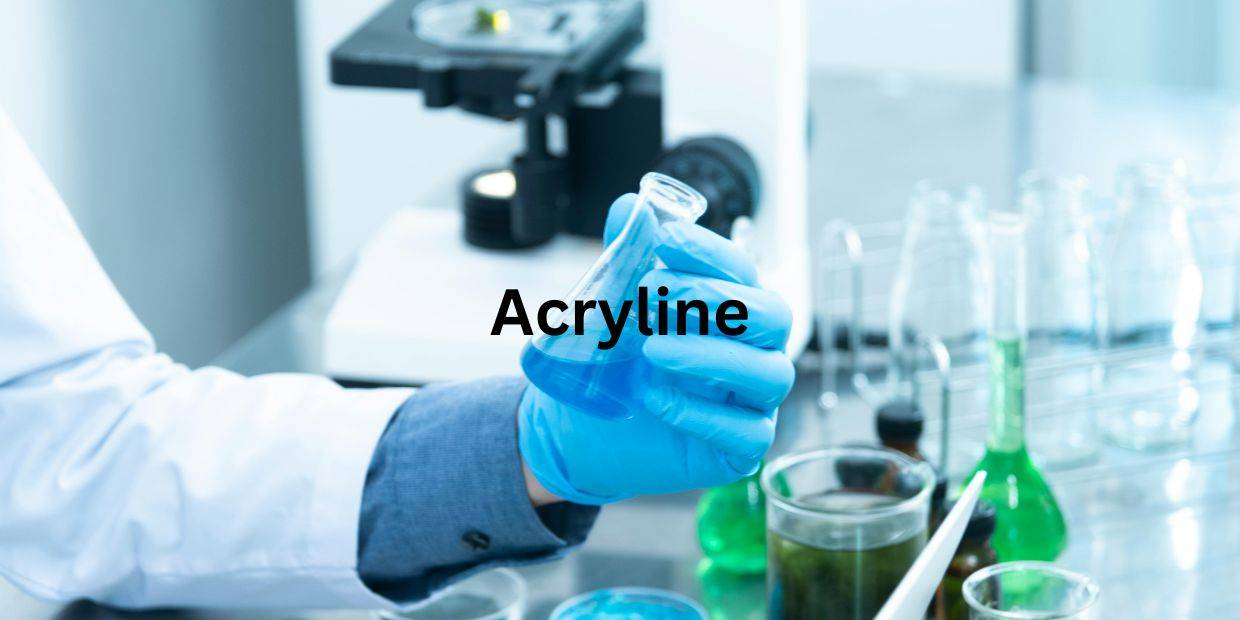Acryline of chemicals and materials names often get interchanged or misspelled leading to confusion. One such term that has been floating around is Acryline. However upon investigation it appears that Acryline may be a misspelling or variation of two different substances: Acrylamide and Acrylic. Let delve into what each of these actually is and clear up any misunderstandings.

Acrylamide | The Misunderstood Byproduct
It is not an ingredient but rather a byproduct that forms when starchy foods are cooked at high temperatures such as during frying roasting or baking. The longer these foods are cooked the higher the levels of acrylamide. It is also a component found in cigarette smoke classified as carcinogenic to humans.
Acrylamide | A Byproduct of Modern Cooking
This organic compound is not deliberately added to foods it is a byproduct of the Maillard reaction where sugars and amino acids combine to give browned food its desirable flavor.
The discovery of acrylamide in food has led to widespread concern because it has been classified as a probable human carcinogen based on laboratory animal studies. However the levels of acrylamide in foods are typically much lower than those causing cancer in laboratory animals.
The Health Debate Surrounding Acrylamide
The presence of acrylamide in food has sparked a significant health debate. While animal studies have shown that high levels of acrylamide can cause cancer the implications for human health are less clear.
Studies in humans have provided limited and inconsistent evidence of acrylamide’s potential to cause cancer. As a result health organizations worldwide continue to study and evaluate the risks of dietary acrylamide exposure. Meanwhile they advise the public to follow a balanced diet which includes reducing consumption of fried and high-fat foods to minimize potential risks.
Reducing Acrylamide Exposure in Food
Given the concerns about acrylamide there is a growing interest in finding ways to reduce its formation in food. Cooking methods that involve lower temperatures and shorter cooking times can help minimize acrylamide formation.
Additionally ongoing research aims to understand how acrylamide forms and to develop food processing techniques that can decrease its presence. Consumers can also take steps at home such as not overcooking foods and opting for healthier cooking methods like boiling and steaming which do not typically form acrylamide.
Health Implications of Acrylamide
While acrylamide has been shown to cause cancer in animals exposed to very high doses the evidence of its effect on human cancer risk from food consumption is not consistent. However organizations like the U.S. National Toxicology Program and the Joint Food and Agriculture Organization/World Health Organization Expert Committee on Food Additives consider acrylamide to be a human health concern.
Acrylamide | A Public Health Concern
Acrylamide a chemical formed during the cooking of certain foods has raised public health concerns due to its classification as a probable human carcinogen. The formation of acrylamide occurs primarily through high-temperature cooking methods such as frying baking and roasting particularly in starchy foods like potatoes and grains.
While the levels of acrylamide in food are generally low the potential health risks associated with long-term exposure have prompted extensive research and regulatory interest. Health organizations including the World Health Organization and the Food and Agriculture Organization have conducted evaluations on acrylamide focusing on its toxicity genotoxicity and carcinogenicity.
Understanding the Risks of Acrylamide
The health implications of acrylamide are a subject of ongoing scientific study. In laboratory animals high levels of acrylamide exposure have been linked to an increased risk of several types of cancer. In humans however the evidence is less clear. Epidemiological studies have not consistently shown a link between dietary acrylamide intake and cancer risk.
This inconsistency may be due to the challenges in assessing individual acrylamide exposure from diet. Nevertheless the potential for acrylamide to cause DNA damage through its metabolite glycidamide remains a concern and as a precaution efforts are made to reduce acrylamide levels in food products.
Mitigating Acrylamide Exposure
Given the concerns about acrylamide there is a concerted effort to mitigate exposure to this compound. The food industry and regulatory agencies are exploring methods to reduce acrylamide formation during food processing.
Consumers can also play a role by adopting cooking practices that minimize acrylamide production such as avoiding overcooking and choosing cooking methods that are less likely to produce acrylamide like boiling or steaming. Public health advice continues to emphasize a balanced diet and moderation in the consumption of foods that are potential sources of acrylamide as part of a comprehensive approach to reducing overall cancer risk.

Acrylic | The Versatile Fiber
On the other hand acrylic refers to a type of synthetic fiber made from a polymer called polyacrylonitrile. It’s a strong and warm material often used for sweaters tracksuits linings for boots and gloves as well as in furnishing fabrics and carpets. Acrylic fibers are known for their durability and resistance to wrinkles and shrinkage.
The Many Uses of Acrylic
Acrylic fibers are not just limited to clothing; they have a wide range of applications including home furnishings outdoor fabrics and even as precursors for carbon fiber. The production of acrylic fibers is a complex process involving the polymerization of acrylonitrile and often takes place in countries with a strong textile industry presence.
Conclusion
It’s important to note that while Acryline might not be a recognized term in the scientific community the substances it could be referring to acrylamide and acrylic play significant roles in our daily lives from the food we eat to the clothes we wear. Understanding the correct terminology and the substances behind it helps us make informed decisions and discussions.
Also Read This : zxtech
What is commonly referred to as Acryline?
Acryline is often a misspelling or mispronunciation of either acrylamide or acrylic. Acrylamide is a chemical compound that can form in some foods during high-temperature cooking processes while acrylic is a type of synthetic polymer used in various applications.
Is Acryline related to any health risks?
If Acryline refers to acrylamide then yes it is associated with health risks. Acrylamide has been shown to cause cancer in animals at high doses and while the evidence in humans is less clear it is considered a potential human health concern.
How can one avoid exposure to Acryline?
To avoid exposure to acrylamide it is recommended to not overcook starchy foods avoid high-temperature cooking methods like frying and opt for healthier cooking methods such as boiling or steaming. If Acryline refers to acrylic it is not typically a substance that one would be exposed to in a way that requires avoidance.

